The Glowing Eye Nebula is a planetary nebula located approximately 6,500 light-years away in the constellation Aquila (the Eagle). The nebula has an apparent size of 0.40 by 0.36 arcminutes and an apparent magnitude of 11.9. It is catalogued as NGC 6751 in the New General Catalogue.
The Glowing Eye Nebula has a diameter of about 0.8 light-years, which is about 600 times the size of the solar system. The fast expanding bubble formed when an evolved red giant star reached the end of its life cycle and expelled its outer layers. The clouds of ejected material are illuminated by the hot stellar remnant and will eventually dissipate into the interstellar medium.
Planetary nebulae are produced by stars of masses similar to our own Sun. As these stars lose their outer gaseous layers, the hot stellar cores are left exposed. Their strong ultraviolet radiation ionizes the surrounding gas, causing it to glow as a planetary nebula.
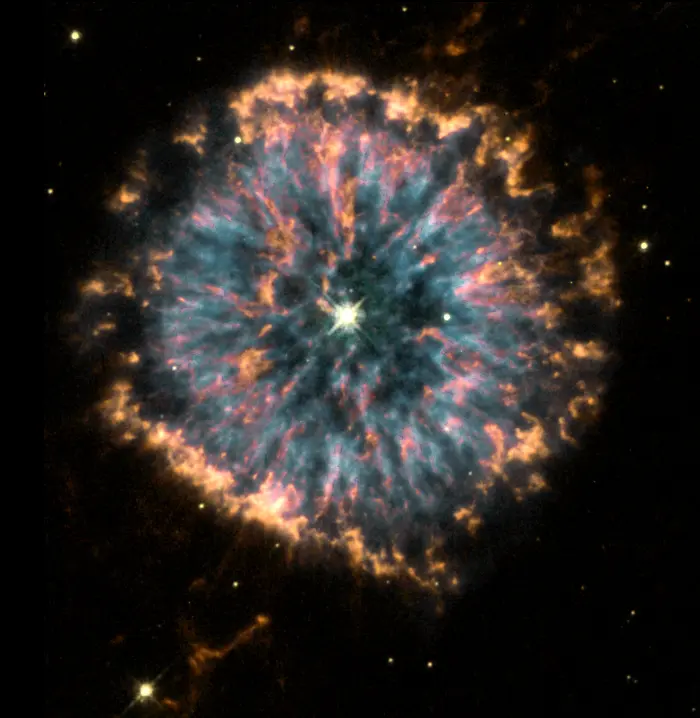
Astronomers using NASA’s Hubble Space Telescope have obtained images of the strikingly unusual planetary nebula, NGC 6751. Glowing in the constellation Aquila like a giant eye, the nebula is a cloud of gas ejected several thousand years ago from the hot star visible in its center. The Hubble observations were obtained in 1998 with the Wide Field and Planetary Camera 2 (WFPC2) by a team of astronomers led by Arsen Hajian of the U.S. Naval Observatory in Washington, DC. The Hubble Heritage team, working at the Space Telescope Science Institute in Baltimore, has prepared this color rendition by combining the Hajian team’s WFPC2 images taken through three different color filters that isolate nebular gases of different temperatures. The nebula shows several remarkable and poorly understood features. Blue regions mark the hottest glowing gas, which forms a roughly circular ring around the central stellar remnant. Orange and red show the locations of cooler gas. The cool gas tends to lie in long streamers pointing away from the central star, and in a surrounding, tattered-looking ring at the outer edge of the nebula. The origin of these cooler clouds within the nebula is still uncertain, but the streamers are clear evidence that their shapes are affected by radiation and stellar winds from the hot star at the center. Image credit: NASA/ESA (Hubble Space Telescope) (PD)
The Glowing Eye lies in a gas-rich region near the galactic plane and is interacting with the interstellar medium. The nebula itself has a bipolar structure with multiple shells and filamentary bipolar lobes. The inner bubble is surrounded by a knotty ring and two fainter halos, visible in the image captured by the Gemini South telescope in Chile in 2009, which shows the extended nebulosity beyond the inner bubble.
The fragmented outer halo stretches around 50 arcseconds from the central star. It was probably formed when the central star started expelling material while on the asymptotic giant branch (AGB).
The inner halo appears more spherical and has a radius of 27 arcseconds. It is believed to have been produced during a later episode of mass loss.
The central bubble has an expansion velocity of 41.8 km s-1 and the knotty ring expands at around 40 km s-1. The diffuse material around the ring expands much faster, at around 90 km s-1 and is thought to be directly associated with a fast wind in the nebula’s central region.
The central bubble, bipolar lobes and the knotty ring formed 3,000 – 5,000 years ago, while the spherical halo has an estimated age of 100,000 years. The outer filamentary halo is the oldest structure in the nebula, but its age is difficult to pinpoint because it is interacting with the interstellar medium.
The central star of NGC 6751 may have undergone a “born-again” episode, a late thermal pulse in the post-AGB phase, when it started to fuse helium again for a couple of hundred years before evolving towards the white dwarf phase again.
The details of the bright inner region – the glowing eye of NGC 6751 – can be seen in images taken by the Hubble Space Telescope (HST). The inner shell has knots surrounded by lobes on the west and east sides. It is highly structured, which gives it the appearance of an eye in space.
The Gemini South image also shows a faint nebula about 80 by 40 arcseconds across at the top left of the image, about 2 arcminutes northeast of the Glowing Eye Nebula. The faint wisps of gas are also being ionized by the central star of the Glowing Eye. They were once thought to be an extended filamentary nebulosity associated with NGC 6751. However, analysis of the kinematics with respect to the Glowing Eye indicated that the nebulosity was part of the local interstellar medium. It was not produced by the central star of NGC 6751.
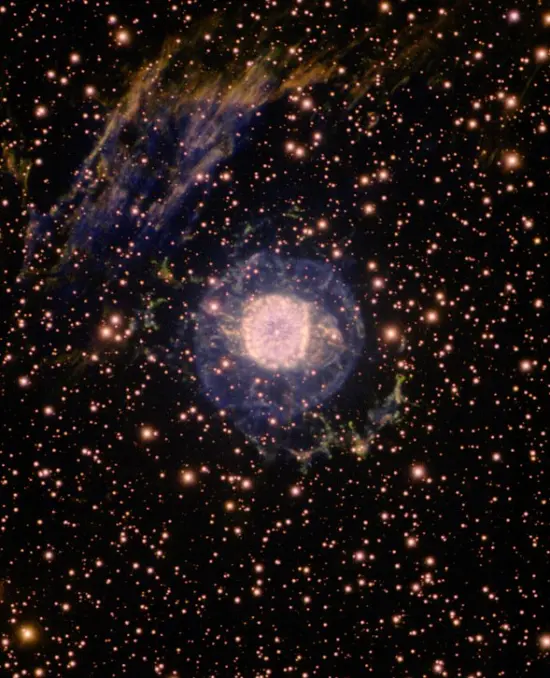
Gemini South image of planetary nebula NGC 6751, the “Glowing Eye Nebula.” The image is the result of the winning entry in the 2009 Gemini School Astronomy Contest, submitted by high school student Daniel Tran of PAL College, Cabramatta, NSW, Australia. Using narrow-band filters in the imaging mode of the Gemini Multi-object Spectrograph (GMOS), the locations of hydrogen, ionized sulfur, and doubly-ionized oxygen are color-coded in the image as yellow, red, and blue, respectively. The 3,000-year-old Glowing Eye Nebula is located about 7,000 light years from Earth and the bright inner portion of the nebula has a diameter of about 0.8 light years. In addition to the emission of the nebula, other wisps of gas in the interstellar medium (upper-left-hand corner of the image) are being ionized by the nebula’s central star, which has a temperature of over 100,000 degrees Celsius. Image credit: International Gemini Observatory/NOIRLab/NSF/AURA/D. Tran (PAL College)/T. Rector (U. Alaska Anchorage)/T. Bridges (Queen’s U.)/Australian Gemini Office (CC BY 4.0)
The faint emission nebula near the Glowing Eye was discovered by French researchers C. T. Hua of the Laboratoire d’Astronomie Spatiale du CNRS in Marseille, and R. Louise of the Faculté des Sciences d’Amiens in Amiens, in 1990. Hua and Louise detected the faint filaments while looking for haloes around planetary nebulae.
The central star of NGC 6751 is catalogued as HD 177656. It has the spectrum of a Wolf-Rayet star and has been given the stellar classification [WC4]. The star has a surface temperature of around 140,000 K and its surface is composed mostly of helium and carbon. The star has a radius only 13% that of the Sun. It is losing mass at an accelerated rate of 1 x 10-6 solar masses per year.
Facts
The Glowing Eye Nebula was discovered by the German astronomer Albert Marth on July 20, 1863. Marth used a 48-inch reflector and spotted the nebula from Malta. The nebula was later listed as NGC 6751 in the New General Catalogue, compiled by the Danish astronomer John Louis Emil Dreyer.
The French astronomer Édouard Stephan discovered the nebula independently with a 31-inch Foucault reflector on July 17, 1871, which led to it being listed as NGC 6748 in the New General Catalogue. It is now only referred to as NGC 6751.
The planetary nebula nature of NGC 6751 was recognized by the Scottish astronomer Williamina Fleming, assistant to astronomer Edward Pickering at Harvard University, in 1907.
NGC 6751 is sometimes called the Dandelion Puffball Nebula. It is one of the several relatively bright planetary nebulae in Aquila, along with the brighter but smaller Phantom Streak Nebula (NGC 6741), the Snow Globe Nebula (NGC 6781), and NGC 6790.
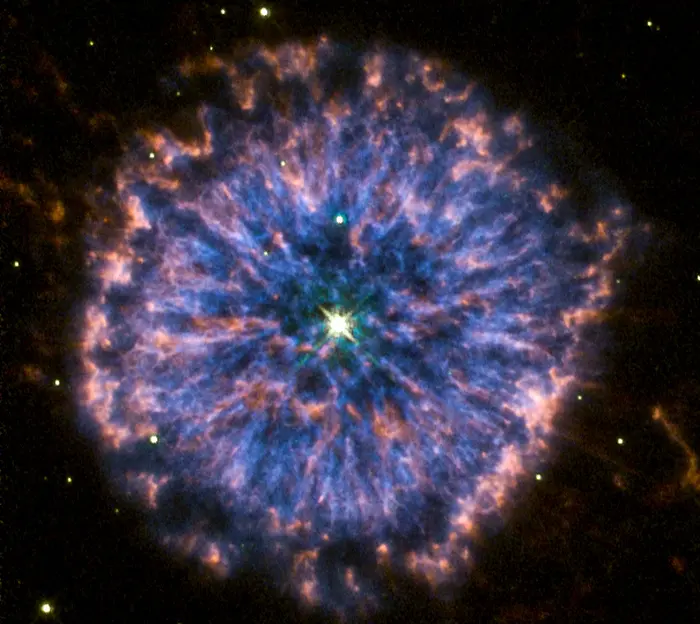
The Glowing Eye Nebula by the Hubble Space Telescope, image credit: NASA/ESA/Hubble/Kevin M. Gill (CC BY 2.0)
Location
The Glowing Eye Nebula lies in the equatorial constellation of Aquila. At declination -6°, it is visible from most locations on Earth for at least part of the year. The nebula is a popular target for amateur astronomers and astrophotographers.
The Glowing Eye appears in the region of the Eagle’s tail, near the exceptionally red variable carbon star V Aquilae and a semi-circle formed by the hot blue star Lambda Aquilae (mag. 3.43) with several fainter stars in Aquila and Scutum (the Shield). The nebula lies in the same area as the bright Wild Duck Cluster (Messier 11), an open cluster in Scutum.
The constellation Aquila is very easy to find during the northern hemisphere summer. It appears between the bright Northern Cross in the constellation Cygnus (the Swan) and the Teapot in Sagittarius (the Archer). The Eagle and the Swan appear to fly opposite each other in the sky. Altair, Aquila’s brightest star, forms a bright, large asterism known as the Summer Triangle with Deneb in Cygnus and Vega in Lyra. Altair is easy to recognize because it is flanked by two other relatively bright stars. The rest of the bird-like constellation figure of Aquila stretches towards Sagittarius in the southern sky.
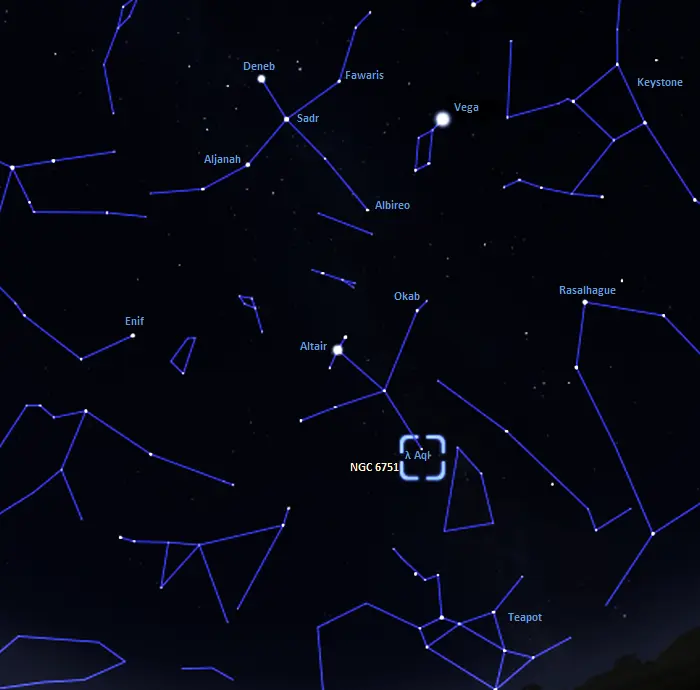
The location of the Glowing Eye Nebula (NGC 6751), image: Stellarium
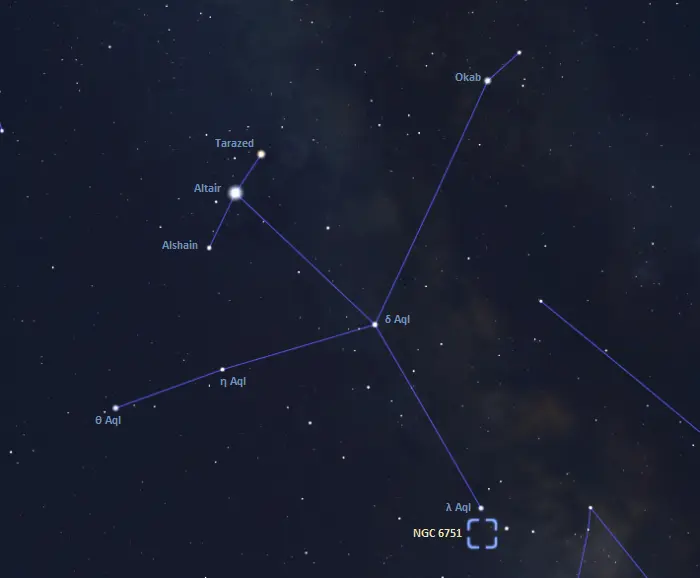
NGC 6751 location, image: Stellarium
The best time of the year to observe the Glowing Eye Nebula and other deep sky objects in Aquila is during the month of August, when the constellation appears higher above the horizon in the early evening.
Glowing Eye Nebula – NGC 6751
| Constellation | Aquila |
| Object type | Planetary nebula |
| Right ascension | 19h 05m 55.5383775432s |
| Declination | −05° 59′ 32.288861544″ |
| Apparent magnitude | 11.9 |
| Absolute magnitude | 0.4 |
| Apparent size | 0.400’ x 0.360 |
| Distance | 6,500 light-years (2,000 parsecs) |
| Radius | 0.4 light-years |
| Names and designations | Glowing Eye Nebula, Dandelion Puffball Nebula, NGC 6751, PK 029-05 1, PN Th 1-J, PN ARO 101, PMN J1905-0559, PN Sa 2-382, PN G029.2-05.9, PN VV’ 477, PN VV 219, HD 177656, GSC 05140-03497, GSC2 S3002210353, CSI-06-19031, EM* CDS 1043, HuLo 1, GCRV 11549, IRAS 19032-0604, 2MASX J19055556-0559327, SCM 227, WEB 16300, UCAC2 29903231, Gaia DR2 4206136209740612352, Gaia DR3 4206136209740612352 |